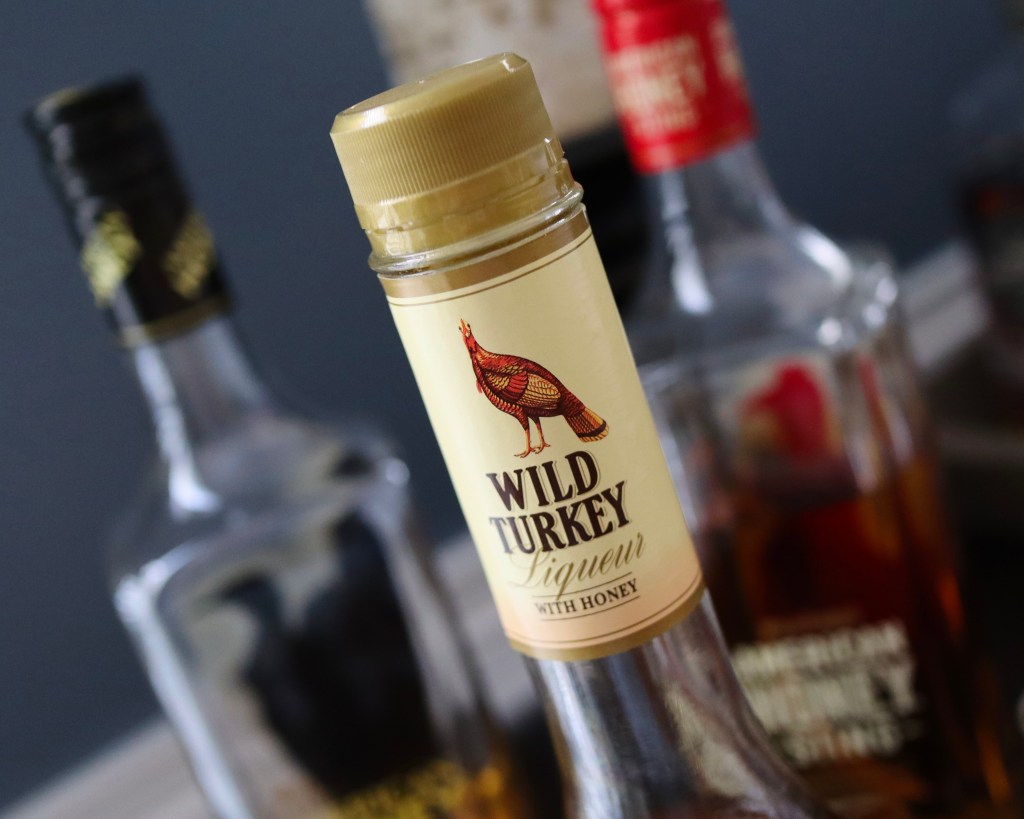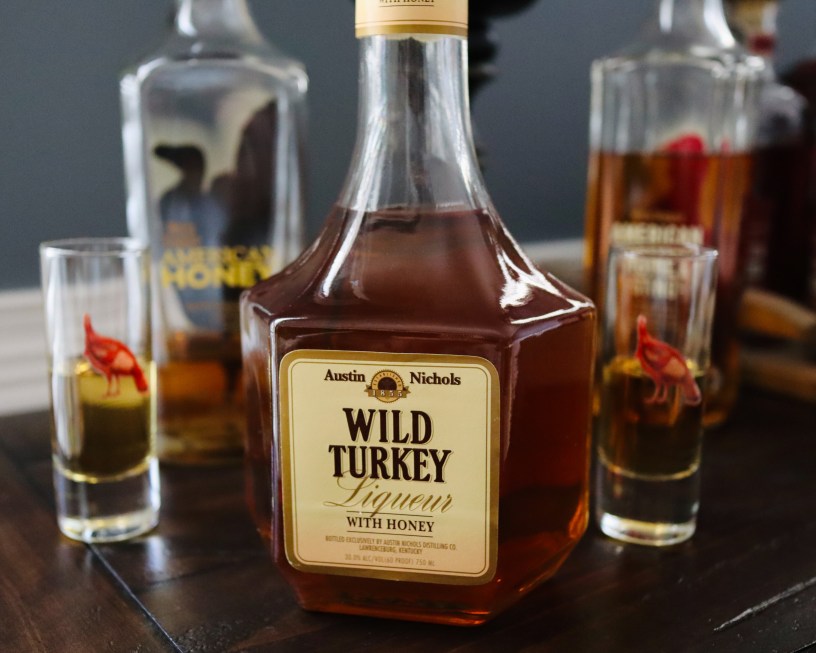Bourbon liqueurs … you see them everywhere – cinnamon, maple, peach, cherry, etc. They’re so common and popular, you might think they’ve been around forever. But they haven’t. And little do most folks know, it all started with Jimmy Russell.
While whiskey-based liqueurs have been around since the late 1800s (possibly earlier), It wasn’t until 1976 that the world welcomed its first mass-produced bourbon-based liqueur. Aptly called Wild Turkey Liqueur, the 80-proof spirit was a proprietary blend of bourbon and natural honey. The idea being, the sweetened whiskey would draw a new and more diverse audience to Wild Turkey, which was beginning to feel the strains of bourbon’s decline. It was a success, though it couldn’t save the distillery from the infamous “Glut Era.” But to some measure, it helped keep the lights on and exists today as Wild Turkey American Honey.

This past week, thanks to the generosity of a friend (appreciate it, David), I had some good fortune. I was able to procure a retail-priced, factory-new 1997 Wild Turkey Liqueur gift set (not to mention, two different 2022 Kentucky Spirit bottlings). I guess there are some cool things still out there, if you look hard enough. Granted, it’s a liqueur, and I’m doubtful that most dusty hunters are browsing a store’s flavored whiskey selection. Still, twenty-five years sitting on a shelf. Why not give it a try?
This is the part of the review where I usually provide tasting notes based on a spirit’s nose, taste, and finish. Having reviewed both American Honey and American Honey Sting, I’ve come to the realization that profile notes for these types of expressions, while arguably helpful for some readers, serve minimal purpose. After all, this isn’t the sort of spirit one contemplates and examines in depth. It’s consumed by the masses for pure enjoyment. Some shoot it. Some sip it. Some mix it with iced tea. How a bourbon liqueur is appreciated is solely up to the individual – be it a casual drinker or diehard enthusiast – and should be, without guilt or shame.
And then it occurred to me – I know exactly how to evaluate this liqueur. I’ll use the two full-color, forward-facing Turkey shot glasses that were included in the gift set. An ounce of the 1997 Wild Turkey Liqueur for one, and an ounce from a 2015 bottling of American Honey in the other.
Bottoms up!

Wild Turkey Liqueur (1997 bottling) – “a unique and extraordinary delicious liqueur” crafted with “100% pure natural honey” – 60 proof – no age stated – bottled by the Austin, Nichols Distilling Co., Lawrenceburg, KY
Tasted “straight up” in a Wild Turkey shot glass …
Impression: Syrupy, sweet, and slightly funky. Vanilla and honey are the dominant notes, followed by citrus and sugary oak. It’s certainly nothing to brag about, though it’s not half bad for a shooter. I could see this tasting better mingled with some Wild Turkey 101. Perhaps I’ll try that later.
Wild Turkey American Honey (2015 bottling) – “a liqueur blended with pure honey and bourbon whiskey” – 71 proof – no age stated – bottled by the Austin, Nichols Distilling Co., Lawrenceburg, KY
Tasted “straight up” in a Wild Turkey shot glass …
Impression: This is one of those rare exceptions where I can say with confidence that modern-day Turkey is better than its dusty predecessor. Not that Wild Turkey Liqueur is significantly inferior; American Honey is simply more flavorful and complex in comparison (not sure if “complex” is the best word here, but whatever).
All said and done, American Honey is far more vibrant and citrus-forward (primarily orange) when tasted next to Wild Turkey Liqueur. It should be noted, however, that there is a proof difference between the two. Wild Turkey Liqueur is 60 proof (by the 1990s it dropped from its original 80 proof to 60) and American Honey is 71 proof (gotta stay on-brand with that extra “1”).
But I’m not done yet!
Before I claim Wild Turkey American Honey the victor in today’s side-by-side tasting, I’d like to venture one more comparison – blending equal parts liqueur and straight bourbon. I’ll go with 101 over ice. Consider it a pair of “poor man’s” cocktails. No bitters. No garnish. Hell, I don’t even need a jigger. I’ll just eyeball it.
Cheers!
I should’ve known. The 101 and Wild Turkey Liqueur combination, while sweet and somewhat tasty, falls a bit flat. And though the 101 adds a great deal of character and “oomph,” it fails to come across as something I’d appreciate sipping at length. It’s just sweet, cold, and boozy.
On the other hand, the 101 and American Honey is pretty damn good for the sum of its parts. I’d wager this could pair well with a medium-bodied cigar, like an Alec-Bradley Tempus Natural. Speaking of which, I think that’s precisely what I’ll do when I finish this write-up (for science, of course).
Well, that was fun! So often my blog posts center around the serious or critical, be it articles or reviews. Admittedly, it’s nice to take a break from that angle and try new things – even unconventional things – and see what comes from it.
If there’s any takeaway from today’s post, it’s to avoid paying more than retail price for vintage bottles of Wild Turkey Liqueur (at least, if you’re planning to drink it). They’re cool bottles to look at, but outside of that you’ll get more mileage from an everyday bottle of American Honey. Speaking of which, if I were Campari, I’d be looking at ways to bring the hexagonal bottle back. A limited-edition liqueur? Why not? With certain honey-finished whiskeys commanding notable premiums on secondary markets, it only seems appropriate.
dj
Enjoy this blog? Please consider supporting it via Patreon. In return you’ll receive access to exclusive rewards and weekly whiskey content. Thank you! dj



It’s all in them glasses!
Pretty cool, right?!
I have to say, I do enjoy finding and collecting old WT glassware (in addition to the dusty bottles!). Those are some neat shot glasses, but I have a set of WT “highball” glasses with a line to mark pouring level of your spirit and I use them all the time.
Some of those old Turkey glasses are hard to beat!